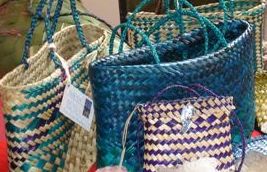A Maori Craft
Today I went to a Raranga demonstration and learnt the art of flax weaving - that is I made a few simple roses with the aid of a marvellous Maori teacher! This simple weaving and plaiting is done without the aid of any loom or other materials - just with the fingers.
The Maori teacher, Emma, was an amazing woman, who apart from teaching Maori crafts also runs the local kindergarden while caring for her big family. She also collects flax and weaves.
In Maori the flax is called Harakeke and for centuries has been used for mats, baskets, fishing nets and bird traps. Very strict protocols are followed when harvesting this treasure. Before the harvesting a special prayer is said for the area, the plant and life in general, and the cutting can only take place in daylight and during fine weather. The cutting of outer leaves is allowed but inner leaves must not ever be touched.
When weaving, again strict protocols are followed, menstruating and pregnant women may not take part and the first woven article must always be given away as a gift. Children and food must not be near the weaving area and sacred songs, prayers and Maori proverbs are to be sung or recited during the weaving process.
| Flax |
 |
| Flax |
New Zealand Flax (The Phormium or Harakeke) grows locally in the wild and is collected in bundles, while being cut carefully so as not to damage the plant and its future growing abilities. At this point it looks like this ...
These cut reeds were around five feet long and about one and a half inches across. They are quite firm and a little porous emitting a highly effective laxative (top tip to myself to wash my hands thoroughly before I leave!)
The rose weaving was a fiddly process and needed two hands - hence no pics of the proceedure. Needless to say I was not very good at it but still managed to make some fairly decent flowers.
At this point the flax is a bright green but over a few days while drying it becomes a pale straw colour. Many of the woven goods are dyed with a natural dye, which was bubbling away in a pot on the verandah.
After a quick dip the flowers became a lovely beetroot colour - apparently when eventually dry this will dull down to a softer shade of red.
The Maori women all sat around a large table at The Heritage Centre, Founders Park, in Nelson, NZ., making mats, pots and bags, which are sold in local craft shops. Many were intricate works of art.
 |
 |








What a wonderful opportunity to try something new.
ReplyDeleteWow! Love the roses! Thanks for taking us along. I enjoyed learning about this, Annabelle. xx
ReplyDeleteWow! Love the roses! Thanks for taking us along. I enjoyed learning about this, Annabelle. xx
ReplyDeleteAmazing talent!
ReplyDeleteGreat to see different crafts.
ReplyDeleteLove these xxx
ReplyDeleteWhat a great activity. You recovered from jetlag then?
ReplyDelete